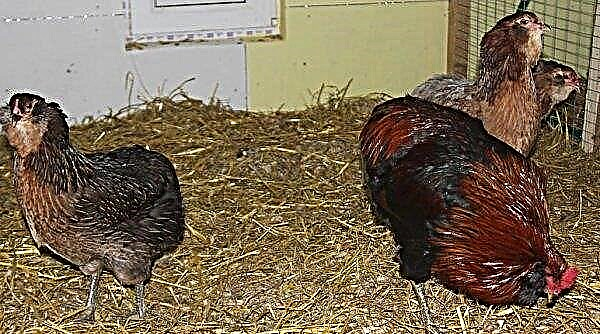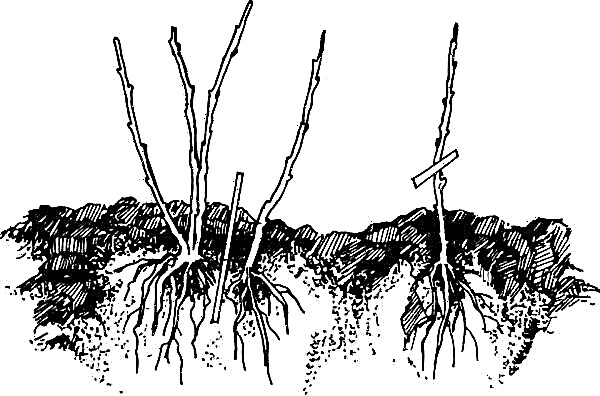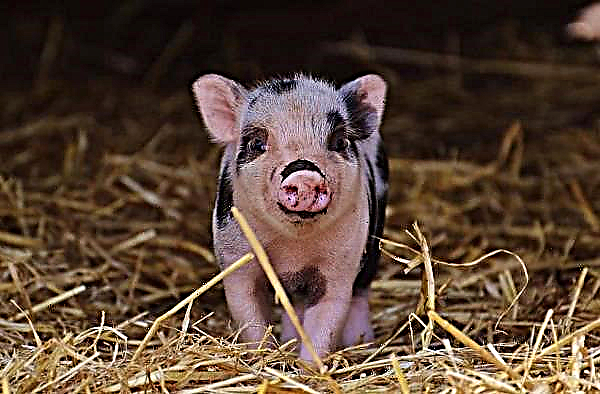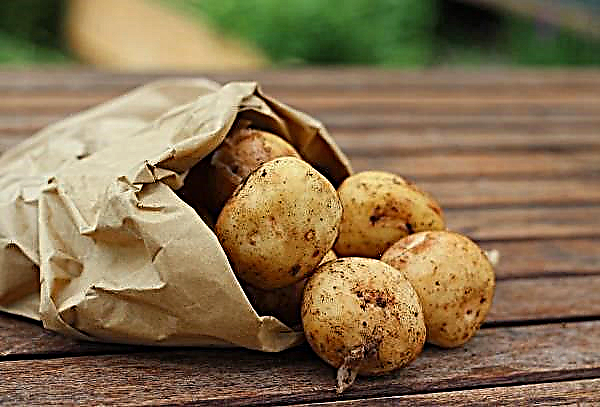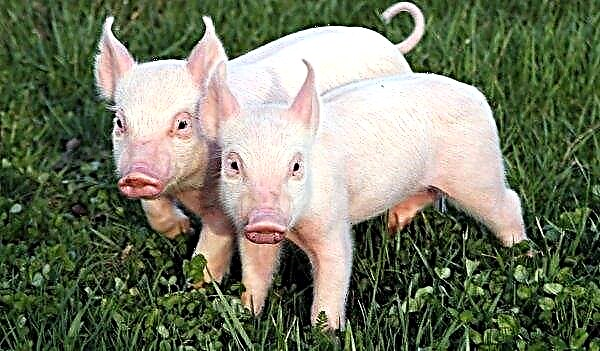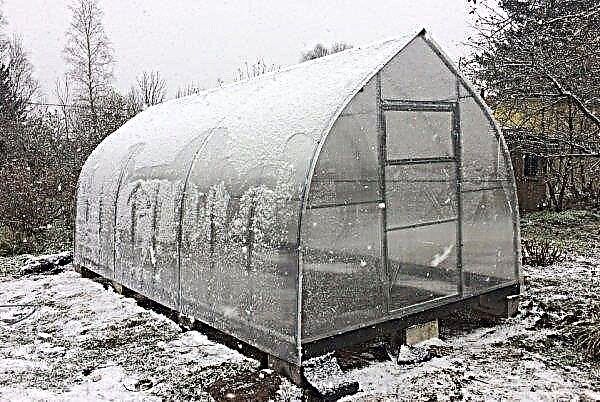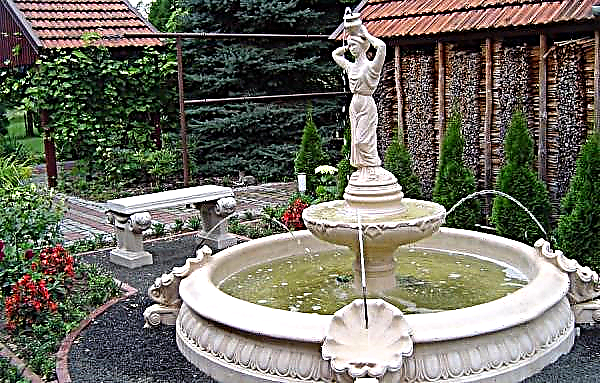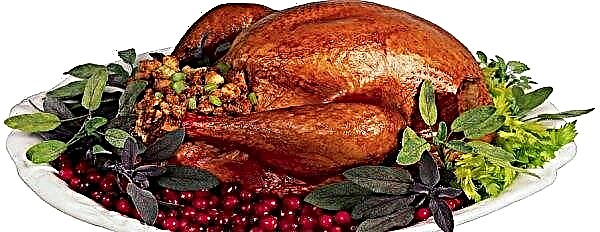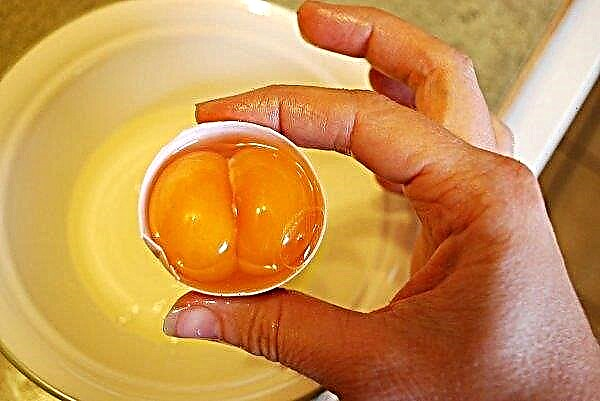In recent years, interest has grown markedly in the cultivation of gooseberries in home gardens and on an industrial scale. Gooseberry attracts, first of all, with its delicious sweet berries, and also as very interesting as an ornamental plant for landscape design. To achieve both the first and second, it is necessary to competently take care of the plant. And, of course, it is advisable to start your acquaintance with a gooseberry variety that is quite easy to care for, but effective and effective. About this sort - this article.
Selection history
The Himalayas is considered the homeland of gooseberries, but now it can be found in almost all climatic zones. In Europe, gooseberries were first mentioned in the 13th century in France, starting in the 16th century in Germany and England. It is mentioned immediately as an ornamental shrub. However, from the beginning of the XVII century gooseberries - the favorite berry of the British, already having a number of varieties.
Did you know? Fragrant kiwi is a cultivated Chinese gooseberry.
All varieties of the Western European gooseberry group come from a wild species - Crossularia reclinata (Z) Mill. In the process of applying the best methods of cultivation, there was an improvement in taste, yield and other characteristics. A special place was given to the size of the fetus. Gradually, these subtle changes accumulated and new varieties of the berry were formed.
At the beginning of the XIX century in England, there were about a thousand varieties of gooseberries. Very often, the names of varieties were given in the area where they were bred. The most famous were gooseberries from Lancashire: Lancashire guy, Lancashirets, White smith, Lancashire girl.
Most likely, under the name White Smith (blacksmith - blacksmith), the White Triumph cultivar began to be grown in Germany. And then during the breeding, he was already renamed by the Germans to the White Triumph (weisse Triumph Veer).
In literature, one of the oldest dessert varieties and the highest yielding of all white varieties is White Triumph, often called White Triumph (this is a Russian transcription of the English name of the variety).
Characteristic and Description
Variety White Triumph stands out amazingly tasty sweet fruits of a rather large size. The bush is formed slightly spreading, spherical, but powerful enough (up to 1.5 m high). The branches are not thick, directed obliquely upward. On the whole branch there are large spikes (mostly single). The leaves are small, without fringe, green, but the shoots above may be reddish.
Did you know? Bees really like gooseberries: they collect more than 50 kg of honey per hectare.
The color of the berries changes from grayish-green at the beginning of ripening to milky yellow with a whitish tint at full maturity. Berries are hairy, the skin is thin. The berries are rounded in shape with highly branched greenish-white veins. The pulp is light green, exceptionally bright aroma. Ripening period - June - July. Even after full ripening, the berries remain on the bush, do not fall.
Advantages and disadvantages
Gooseberries are often called “northern grapes” (it contains 8–11% of sugars and is second only to grapes in this indicator), “royal berry”. This is not surprising, because it contains about 16% of substances valuable to the human body (except fructose, glucose and sucrose, - organic acids, pectins, vitamins (C, P, Bl, etc.), minerals) - a real natural concentrate of vitamins and trace elements.

The use of fresh berries contributes to the prevention and treatment of cardiovascular diseases. Infusion of fruits reduces the accumulation of cholesterol.
Did you know? Gooseberry juice, due to the presence of a significant amount of pectin, removes radionuclides and salts of heavy metals from the human body, thus relieving the symptoms of radiation infection.
In ripe berries, a lot of serotonin, which has an antitumor effect, cures anemia. In addition, gooseberry juice helps to normalize metabolism. It is not surprising that the popularity of the berries is constantly high.
- The minuses of the White Triumph variety include:
- the presence of impressive sharp spikes throughout the shoot;
- lack of stability against the library.
Drought resistance, frost resistance
The main gooseberry root grows deep enough, reaching subsoil waters, therefore, in general, the plant is drought tolerant, although it likes watering. This is especially true for certain periods of shrub vegetation: immediately after planting, during filling and ripening of fruits. It is especially necessary to pay attention to the shelter of early ovaries and flowers from spring frosts and to insulate the roots in the snowless period of November - December.
 The variety is fairly winter-hardy, but gooseberries can be covered with snow, spruce branches, and dry leaves from severe frosts.
The variety is fairly winter-hardy, but gooseberries can be covered with snow, spruce branches, and dry leaves from severe frosts.
Productivity and fruiting
The undoubted advantage of the White Triumph variety is delicious large berries (reach 13-15 g of weight) and abundant harvests - from the bush you can collect up to 23 kg of berries).
Important! EIt is effective during budding to spray the kidneys with a solution of ammonium sulfate or urea. This has a positive effect on increasing the yield of gooseberries.
White Triumph is quite unpretentious, and subject to all the gooseberry's general rules of agricultural technology, planting and caring for the plant will not cause additional difficulties.
Landing
Gooseberries are garden centenarians. The duration of fruiting largely depends on the quality of the soil. If the fertile layer is deep enough, gooseberry bushes older than 20 years can bear fruit.
 If the soil is infertile (sandy or peaty), the bushes are effectively fertile - 10-12 years.
If the soil is infertile (sandy or peaty), the bushes are effectively fertile - 10-12 years.
The timing
Gooseberry seedlings can be planted both in autumn (mid-September - early October), and in spring. The difficulty of spring planting is to “catch” the right time, when the ground has already thawed, but the buds have not yet burst. If you manage to do this, then the survival rate of plants is 100%. Autumn planting is good because it allows plants to take up and form new young roots.
Choosing the right place
The soil for gooseberries is slightly acidic, neutral or slightly alkaline, fertile and loose. The plant is light and heat-loving (but does not like heat), does not tolerate drafts.
In the spring during flowering and in the summer during ripening, gooseberries are sensitive to a lack of moisture. However, the plant does not tolerate moisture stagnation: if a high level of groundwater is about 1.5 m or the soil is swampy, then it is impossible to grow a quality berry bush on the site, so lowlands are not suitable for planting.
Important! The most sensitive inconvenience when caring for gooseberry bushes — the presence of thorns, therefore, weeds (especially those that have long roots) must be removed on the site planned for planting.
When choosing a place to plant, you must remember that gooseberries do not like acidic, swampy and cold soil. The best option for arranging gooseberry bushes is along the south wall of the house or fence.
The sequence of operations when planting gooseberries is the same in autumn and spring:
- Digging holes for planting thorough - with a diameter of 50-60 cm and a depth of about 50 cm, so that the root system is located freely and the roots do not bend.
- Fertilizers are placed in each pit (per 10 kg of humus, 50 g of superphosphate and potassium sulfate, ash can be used) and mixed with the ground. If the soil is clay, add half a bucket of river sand. The fertilizers planted during planting should be enough for 2-3 years.
- Seedlings are lowered vertically into the pit and buried 6-10 cm above the root neck. This will provide an opportunity for growth of new shoots from the root.
- Planted bushes are watered with about 10 liters of water.
- The space under the bush is mulched (with rotted manure, peat, pine or spruce needles, etc.) to prevent dehydration and germination of weeds.
- The planted bush is cut off, leaving the ground part of 3-4 strong shoots.
Gooseberries begin to bear fruit in the third year.

Selection and preparation of planting material
It is very good if the nursery is located within a radius of 200-300 km from the site of the proposed planting of gooseberries (the climatic conditions are largely similar). Before planting, it is worth holding the seedlings in a nutrient solution. Trim rotten and too long roots. The remaining roots should be light, at least 25-30 cm long.
 It is safest to buy seedlings in nurseries with an impeccable reputation or in person from breeders (if possible, see plantings and taste berries before buying).
It is safest to buy seedlings in nurseries with an impeccable reputation or in person from breeders (if possible, see plantings and taste berries before buying).
Landing pattern
The planting scheme depends on the size of the plot and the number of bushes, but in general the distance between the seedlings should be 1.5 m, between the rows - 2 m. It is rational to use a chess layout when planting, in which each bush will have more light and air. Fruiting from this will increase.
Features of seasonal care
White Triumph - An English gooseberry variety, therefore, during all stages of the growing season for him the conditions will be most comfortable, as in his homeland: enough moisture, heat and light. However, these conditions are also ideal for the development of gooseberry fungal diseases, therefore, throughout the entire growth period, the most serious attention should be paid to the prevention of diseases and pests (especially the sphere).
Soil care
In the spring, after the snow cover has melted, the ground under the shrub should be cleaned from rotted leaves and last year's mulch. Burn all this garbage, as it may contain wintering parasite larvae and fungal spores.
 The lateral roots of gooseberries are not deep, so loosening is carried out carefully with a hoe or rake.
The lateral roots of gooseberries are not deep, so loosening is carried out carefully with a hoe or rake.
Further, the soil must be loosened. Open ground also contributes to the warming of the prikustnogo circle. After drying of snow with a lack of moisture, plants need to be watered. About 2-3 buckets of water are enough once a week for each bush.
Watering Mode:
- the first time - on the 10-15th day after flowering;
- the second time - during the loading of berries;
- the third - about a couple of weeks before harvesting.
After watering, it is imperative to mulch the caudal circle. Abundant sprinkling with cold water leads to the development of fungal diseases, therefore it can not be carried out. Periodically it is necessary to loosen the soil.
In autumn, after harvesting, it is necessary to tidy up the chubby circle: collect fallen leaves, twigs, weeds, dry grass and burn. This will not allow wintering of pest pupae. Before frosts for the same purpose, row-spacings are loosened (to a depth of about 20 cm) and under bushes (depth about 6 cm).
 Gooseberries should be watered under the root with warm, standing water.
Gooseberries should be watered under the root with warm, standing water.
So that the roots of the plant fit snugly against the soil and there are no air "pockets" that weaken the winter hardiness of gooseberry bushes, they carry out water-charging irrigation (at the rate of 50 liters of water per square meter).
Preventative treatment
In early spring (end of February - beginning of March before bud swelling), a preventive dousing of the plant with boiling water is carried out so that water gets on each branch (practically no boiling water gets on the plant, but water is about + 80 ° C; cooler water is ineffective for this operation). For convenience, the bush can be connected. Water consumption - about 2–4 liters per bush. This is the prevention of any pests and diseases.
The method is environmentally friendly, but does not guarantee 100% disposal, therefore, plants are additionally treated with powdery mildew fungicides. Next, the plant is treated twice: the first - when the leaves just begin to appear; the second time - about a week later, when the buds appear.
Important! During flowering treatment of plants from pests is necessary minimize or even stop (this is the period of activity of pollinating insects).
To combat firefly larvae, immediately after the snow melts, the ground under the bushes is lined with roofing material. It prevents the departure of the fire and its death. During this period, gooseberries are also treated twice from glassware.
Summer is the ripening period of berries, and preventive measures come down to a careful examination of the bushes for the early detection of diseases and pests and their control. The use of fungicides and insecticides is possible when more than two weeks are left before the harvest. Otherwise, it is necessary to use folk methods of struggle.
To combat parasitic butterflies and them caterpillars carry out the following activities: brushing and picking larvae from bushes, picking from the leaves of laid eggs and destroying them. In addition, it is necessary to collect and burn diseased leaves and stems in a timely manner.

Despite the fact that the crop has already been harvested, in the autumn the shrubs continue to be protected from pests and are treated with fungicides and pesticides.. After harvesting, gooseberry bushes are sprayed with Bordeaux fluid.
Top dressing
Spring - this is the time to awaken the plant from hibernation and laying the crop. Gooseberry White Triumph is high-yielding, therefore, bushes need a lot of nutrients. You can feed gooseberries in three stages:
- to wake up the kidneys, apply fertilizers containing nitrogen (60 g of ammonium nitrate, 45 g of urea - sprinkle under the bush along the perimeter of the crown and deepen with loosening);
- before flowering, phosphorus and potassium are required (an aqueous solution of chicken droppings 1:12);
- for fruit set (slurry 10 l of water, 3-5 kg of manure, 200 g of wood ash).

Feeding can be done at one time. The following mixture is introduced: per half bucket of compost - 50 g of superphosphate, 25 g of potassium sulfate, 25 g of ammonium sulfate. Filling up fertilizers along the projection zone of the bush, they carry out loosening and mulching of the soil.
In the summer, during the period of growth and fruiting of gooseberries, it is necessary to pay special attention to providing the plant with all the necessary micro and macro elements. Otherwise, the plant will hurt, develop poorly and bear fruit, and in the worst case, it will die.
Important! For better assimilation of fertilizers, top dressing must be done after watering.
Gooseberries are especially necessary for the growth and ripening of berries. phosphoric (superphosphate), potash (potassium sulfate) and organic fertilizers.An indicator of the lack of certain trace elements may be the state of the leaf cover, ovary and root system.
| A lack of potassium leads to: | An insufficient amount of phosphorus leads to: | Nitrogen deficiency will affect: |
| dry and brittle shoots | late flowering | slow growing bushes |
| yellowing and shedding of leaves | shedding of ovaries | underdeveloped shoots |
| fruit chopping | discoloration of leaves from green to red | dull leaf color |
| discoloration of leaves from green to red | few inflorescences |
In the autumn after fruiting, the soil is very poor in trace elements, and in order for the bush to effectively form fruit buds for next year, it is necessary to fertilize. During this period, phosphorus, potash and organic fertilizers are especially relevant.
Important! Unlike spring, in autumn top dressing should not be nitrogen fertilizers. They contribute to the enhanced development of shoots, and this is undesirable in the winter period.
Fertilizers are applied in the area where the bulk of the roots are located (in the area of the projection of the bush), and the soil is dug up.
Support
In order for the sprouted branches to come into contact with the earth as little as possible, and the fruits not to become dirty, not to spoil and to collect them more safely (from thorns), it is necessary to put supports or to tie up the plant. This increases the ventilation and illumination of the bush, and therefore reduces the cause of fungal diseases.

Supports should not obscure the plant.Using fixation, the bushes can be given certain forms: either a stem (in the form of a tree) or trellis (like grapes).
Pruning
Pruning should be carried out throughout the life of the shrub, in stages. When it is best to carry out the main pruning (in autumn or spring), each gardener determines individually, depending on climatic, soil, and other terrain conditions.
Important! The number of branches removed per season, — no more than 1/3 of the total number of branches, otherwise gooseberries can be sick for a long time.
Gooseberry White Triumph does not like thickening: if pruning is not carried out, due to the lack of sunlight and nutrients, the berries become smaller, lose their taste, and yield decreases. In addition, there is an additional possibility of defeat by pests and fungal diseases, therefore, in early spring, as soon as the earth dries from snow, but the plant is still at rest, pruning is carried out: all unnecessary, diseased, diseased and weakened branches are cut.
If the main pruning was carried out in the fall, then in the spring sanitary pruning is carried out. In order to prevent infection of the shrub, pruning places are treated with garden var. In order to get larger berries, pruning early soft green shoots is performed in summer. On these shoots leave several leaves and one berry.
 The purpose of autumn pruning is to form a crown and rejuvenate the bush if necessary
The purpose of autumn pruning is to form a crown and rejuvenate the bush if necessary
Every year after autumn pruning, 8-10 strong shoots are left on the bush and all branches older than 7-8 years are cut. Slices are treated with garden var.
Harvesting and storage
The technical ripeness of gooseberries White Triumph - June - July. The berries collected in this period are already large, have a crispy skin, but with sourness. They are well transported, they can “wait” a line for processing for several days (preferably in a cool room). The collected berries are processed into compotes, preserves, juices.
Important! Gooseberries are picked in the early morning. It is necessary to seize the moment when the dew has just come down, but the bush has not yet had time to dry well: during this period, the thorns are the least sharp.
After 6-12 days, the gooseberry is fully ripe — the berries are soft, sweet, and there is no crunch when biting. The fruits are harvested in dry weather, leaving the stalks. If possible, pick berries in clean, dry containers of up to 6 kg. To maintain quality, they are not poured into another container (berries can be crushed and burst). Fully ripe berries are used for direct consumption, as well as for the production of wine, liquors, tinctures.

Gooseberries are harvested manually. At the same time, the berries remain intact, retain their appearance and useful properties for longer. Depending on the conditions, gooseberries can be stored from 5 days to 3 months.
Winter preparations
Immediately after collecting the entire crop, it is time to prepare for the winter. This includes all the autumn work:
- Processing bushes from diseases and pests.
- Cleaning the near-bush space and burning accumulated garbage.
- Winter feeding.
- Digging the earth in the aisle and cultivating under the bushes.
- Moisture charging watering of bushes.
- Pruning.
 Be sure to mulch the plants (layer of mulch - about 10 cm)
Be sure to mulch the plants (layer of mulch - about 10 cm)
If a cold winter is expected, then additional warming is carried out: the bushes are bent to the ground, fixed and covered. A good insulation is obtained from spruce or pine spruce branches; moreover, it repels rodents and pests.
Breeding methods
Ways of reproduction gooseberries White Triumph:
- by seeds;
- division of bushes;
- layering;
- cuttings;
- vaccinations.
Important! If gooseberries are propagated by layering, cuttings and seeds, you need to be sure of the health of the maternal shrub.
Seeds
Shrubs grown from seeds begin to bear fruit no earlier than the 5th year, and before that they require special care (shelter, protection from pests and diseases), so gooseberries are rarely propagated by seeds. This method is used to produce new varieties. Sow seeds in the fall.

If the planting is postponed to spring, the seeds are stored after mixing them with wet sand (the seeds dry quickly). Shoots can appear both in the summer and in a year. Annual seedlings are transplanted. In the second or third year, fruits appear on them, and selection for further breeding or culling occurs.
Dividing bushes
In early spring, when the gooseberry bushes are still at rest (there is no sap flow), the plant is dug up and divided into separate parts with roots (in this case, young parts of the bush are selected, and old ones are thrown away). Next, the resulting individual bushes are planted in the usual way.
Layering
The most common method of reproduction of gooseberries - horizontal layering. In July, shallow long pits are dug near the bush and not yet completely woody developed shoots are put in them. Layers are fixed in several places with slingshots.

After vertical shoots (about 10 cm) develop on the pinned layers, the grooves are covered with fertilized soil. The earth on dug up branches is periodically loosened, watered. The next year, the layering is overgrown with a good root system, it is separated by secateurs from the main bush and transplanted. On one bush, you can make several layering.
Cuttings
It should be noted that European varieties, including the White Triumph, are not recommended to propagate by green cuttings. For this purpose, you can try to use parts of the branches of spring pruning, previously keeping them in water with an organic growth stimulator. If, after a certain time, signs of growth appear, then the stalk is rooted.
Vaccinations
Vaccination propagation is used to quickly produce large numbers of young new or expensive plants. However, with this method, a wild shoot often difficult to distinguish from the necessary shoots often appears.

Diseases and Pests
Despite the unique advantages of the variety, one of the main disadvantages of the White Triumph is its instability against fungal diseases, especially the sphere library. However, applying the necessary preventive measures in time, you can almost completely save a rich crop from damage.
Gooseberry disease
The most common gooseberry disease is powdery mildew (sferotek). Especially European varieties are subject to it, including the White Triumph. The fungal disease affects all parts of the plant. First, a white coating appears on the leaves, which becomes denser and, finally, turns into a brownish crust. The leaves are folded, the fruits do not develop, fall off.

The most favorable conditions for the development of the sphere are heat and moisture. Hence the measures to combat powdery mildew: preventing thickening of bushes, moderate watering, sanitary pruning, regular removal of dry leaves, twigs, fruits from the ground. In addition, the plant is treated with special preparations before, after flowering and after harvesting. During the growing season, the whole range of preventive measures to combat the disease is also used.
Control measures consist in the prevention and treatment of plants with appropriate drugs.Gooseberry disease that cannot be treated is a mosaic. The diseased plant must be removed and burned.
 The manifestation of diseases such as rust, anthracnose, gooseberry septoria is most likely to be seen on the leaves.
The manifestation of diseases such as rust, anthracnose, gooseberry septoria is most likely to be seen on the leaves.
Gooseberry Pests
On the gooseberry, you can also find pests, most often - shoot aphids and firethrowers. Less common kidney mite, glass and sawfly. They are struggled with with the help of insecticides, folk remedies, and always shaking and collecting from the bushes the larvae laid on the leaves of the eggs and their destruction.
 Due to its excellent taste, good yield indicators, large-fruited, stable gooseberries White Triumph continues to be one of the most popular varieties.
Due to its excellent taste, good yield indicators, large-fruited, stable gooseberries White Triumph continues to be one of the most popular varieties.
Thanks to the exceptional influence of gooseberries on the physiological basis of human health, berry growing is undergoing a rebirth today. Science claims that berries of green-fruiting old, Western European varieties (White Triumph also belong to them) have much more useful substances - they are colored with bright green color by chlorophyll and chlorophyll-bearing tissues are rich in vitamins E, K and folic acid. This perennial plant is perfectly used by the vast majority of gardeners around the world.

